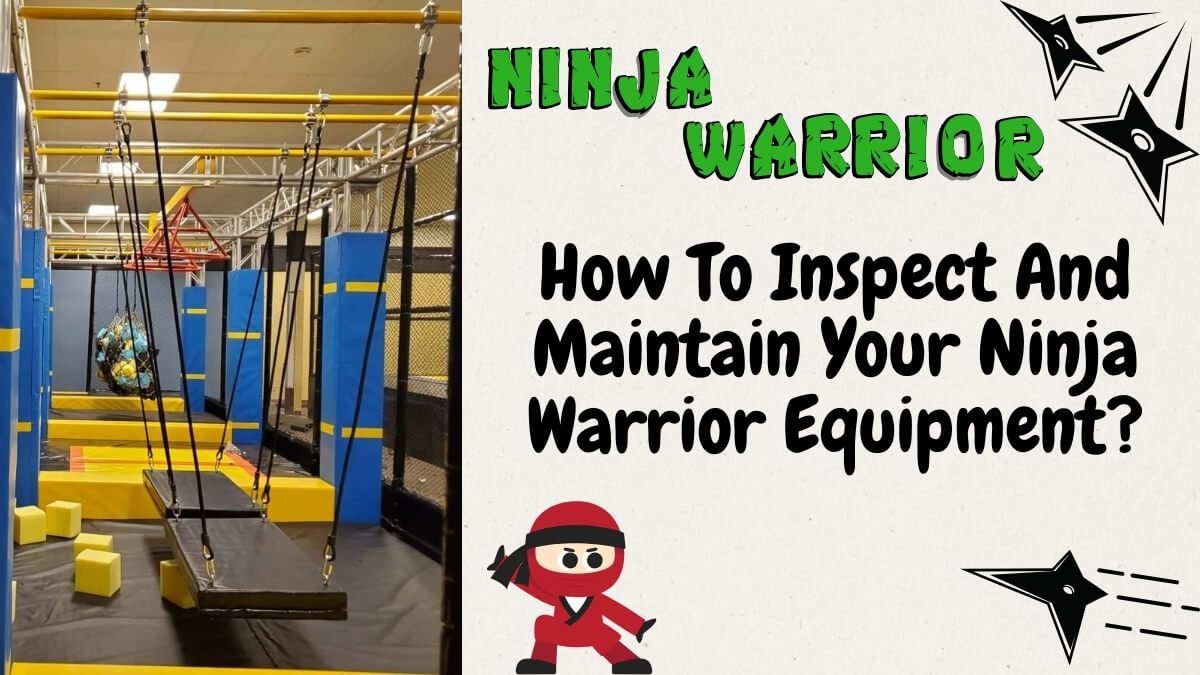Check your Ninja Warrior equipment often for wear, tight bolts, and structural integrity. Clean the surfaces and keep the moving parts lubricated to prevent rust and make sure everything works right. If something gets damaged, replace it right away. Keep up with the safety padding. Keep track of when you inspect, fix, or replace things to make sure everything is safe and you’re following the rules.

How to Inspect and Maintain Your Ninja Warrior Equipment?
If you want to make sure your ninja warrior course stays in great shape, you need to inspect it and maintain it regularly. When your course is in good condition, you reduce the risk of someone getting hurt. Plus, you keep your ninja course open so your customers can have fun and do what they love. Here are the main things to look at when you inspect and maintain your Ninja Warrior equipment:
Regular Inspections
- Daily Checks: Before you open your ninja warrior course to the public each day, do a quick but thorough check. Look for signs of wear and tear, especially on high-use pieces like ropes, bars, and platforms. Make sure all bolts, screws, and clamps are tight and secure so they don’t loosen and create a hazard during operation. Also, don’t forget to check the safety padding that protects users from falls—make sure it’s in place and properly secured. Look at the flooring and landing areas for cracks or deformities, which can create trip hazards or reduce impact absorption when people land.
- Weekly Checks: In addition to the daily visual inspections, every week, do a more detailed check of the equipment. This includes checking the structural integrity of larger components, looking for wear and tear that might not be immediately visible, and making sure the safety padding, ropes, bars, and handholds are still in great shape. Make a note of any parts that are beginning to wear out so you can plan for replacements before they become a safety hazard.
- Monthly Checks: Your monthly inspections should involve a thorough review of the entire Ninja Warrior course. You want to go beyond just the visible areas and inspect internal components that you may not see during your daily or weekly checks. This includes verifying the integrity of the structural support beams, making sure no corrosion has developed on metal parts, and confirming that all moving parts operate smoothly. At this point, it’s important to keep detailed records of your inspections, repairs, and replacements. This will help you stay in compliance with safety regulations and make it easy to track any recurring issues or problem areas.
Maintenance Guidelines
- Cleaning: Keeping your ninja warrior equipment clean is a big part of maintenance. Dirt, sweat, and oils can build up on surfaces, making them slippery and dangerous. Regularly wipe down soft surfaces like foam padding with mild soap and water, or use approved cleaning agents to ensure they stay hygienic. Metal surfaces, such as cross bars and truss frames, should be wiped down with a damp cloth to prevent corrosion, but make sure to dry them completely afterward to avoid rust. For grips, ropes, and handholds, clean them with the right agents to preserve their texture and performance.
- Lubrication: Any moving parts like you find on rotating bars or other interactive elements should be lubricated regularly to keep them working smoothly. Proper lubrication not only prevents wear and tear, but it also enhances the user experience by making sure the equipment works as it’s supposed to. Be sure to use the lubricants recommended by the manufacturer so you don’t damage the materials.
- Replacements and Repairs: No matter how well you maintain your ninja warrior course equipment, parts will eventually wear out and need to be replaced. This is especially true for high-wear items like ropes, grips, or safety padding. If a component shows signs of significant wear or damage, replace it right away rather than trying to fix it on a temporary basis. Always keep spare parts on hand so you have minimal downtime when you need to make repairs.
Now that you understand the basics of inspection and maintenance, let’s talk about why preventive maintenance is important. Waiting until something breaks can cause you to spend a lot of money on repairs and could force you to close parts of your ninja gym, which means you lose money and upset your customers. Preventive maintenance helps you avoid these problems by addressing issues before they become big problems. Plus, when you keep your course in good shape, it sends a message to your customers that you care about their safety, which can help your brand and keep people coming back to your place.
Common Issues Found During Inspections of Ninja Warrior Equipment
Knowing what to look for when you inspect your course can help you concentrate on problem areas and manage risks better.
- Structural Integrity Issues: As your ninja course equipment ages, the structural components may weaken. This can occur from dynamic loads or overuse, especially in places where the equipment undergoes a lot of stress like bars and truss structures. Regularly check for cracks, deformities, or signs of fatigue in the structural components and replace them if necessary.
- Wear and Tear: When people use it a lot, things like ropes, grips, platforms and soft pads wear out. Keep an eye out for frayed ropes and worn-out grips that could cause a safety problem for the people using your course.
- Fastener Issues: People lose things like clamps, bolts, screws, and fasteners. These are the little things that hold your equipment together, so it’s important to check them regularly and tighten or replace them as necessary.
- Safety Equipment Malfunctions: You need things like padding, harnesses, and other safety stuff to keep people from getting hurt. If any of these are damaged or not properly secured, it can result in serious injuries. Always ensure safety equipment is in good condition and immediately replace anything that is worn or broken.
- Improper Use and Maintenance: If you don’t use your equipment the right way or take care of it, it can be dangerous. Make sure your people know how to use and take care of it, and make sure you have signs up for your customers so they know how to use your stuff safely.
Common Causes of Damage to Ninja Warrior Equipment
Several things can cause Ninja Warrior equipment to break, and knowing what these are can help you keep it from happening.
- Dynamic Loading: Ninja warrior courses are dynamic, which means the equipment gets hit hard when people jump, swing, and fall. This can lead to fatigue in the structure, loosening of fasteners, and eventually things breaking. When people swing on ninja course, it puts extra stress on the obstacles, which can make them break if they aren’t designed right.
- Improper Use: Players may unintentionally exceed the weight limits of certain obstacles, leading to structural damage or failure. If players don’t use the obstacles the right way, it can put a lot of stress on the stuff, and it can break or wear out fast.
- Lack of Maintenance: If you don’t check your obstacle course regularly, small problems can turn into big problems. For example, loose bolts or worn-out parts may go unnoticed until they cause significant damage. If you use the incorrect replacement parts to fix things or don’t take care of known problems right away, you can make the damage even worse.
- Material Fatigue: IContinuous use leads to material fatigue, especially in components made from metals or plastics that may not be designed for high-impact applications. This can make them crack or break. Things like ropes, swings, and pulleys are especially prone to breaking from moving back and forth all the time.
- Improper Installation: If you install your ninja warrior course incorrectly , it will lead to uneven stress distribution, increasing the risk of damage during use. This includes misaligned frames or improperly secured fasteners. If you use parts that are not compatible with each other (like mismatched weight collars on cross bars), it can cause things to break when people use them.
Best Methods for Sanitizing Ninja Warrior Equipment
Sanitizing ninja warrior equipment is important to keep a safe and clean environment, especially with all the physical activity that goes on. Here are the best ways to properly sanitize and disinfect this equipment:
- Use Sanitizing Wipes: Regularly use EPA-approved disinfectant wipes on surfaces that come into contact with sweat and skin. Make sure to wipe down all high-touch areas like grips, bars, and mats after each use to kill germs and bacteria effectively.
- Spray Disinfectants: Use sprays with at least 70% isopropyl alcohol or other approved disinfectants. Spray the equipment thoroughly and let it sit for the recommended “wet time” specified by the ninja course manufacturer (usually around 4 minutes) to ensure effective disinfection. Consider using handheld sanitizing devices like Nano Atomizers that create a fine mist of disinfectant, allowing for even coverage without leaving wet residues. This method is great for quickly sanitizing different surfaces.
- Use Soap and Water: Begin with a cleaning solution of soap and water to get the dirt and grime off before you apply disinfectants. This step is crucial as disinfectants work best on clean surfaces.
- Deep Clean Regularly: Schedule regular deep cleaning sessions where all equipment is thoroughly cleaned and sanitized. This can include soaking mats in a disinfectant solution or using steam cleaning methods for deeper penetration.
- Air Drying and Ventilation: After sanitizing, allow your ninja park equipment to air dry completely, which helps eliminate any residual moisture that could breed bacteria or mold. Also, make sure that the area where the ninja warrior equipment is stored or used is well-ventilated to help reduce humidity levels, which can foster mold and mildew growth.
- Wear PPE(Personal Protective Equipment) During Cleaning: When sanitizing equipment, wear gloves and masks to protect yourself from exposure to chemicals and contaminants during the cleaning process.
Conclusion
Maintaining and inspecting your ninja warrior equipment isn’t just about ensuring a fun experience for your customers—it’s about prioritizing safety, reducing downtime, and extending the lifespan of your investment. By following these inspection and maintenance guidelines, you’ll keep your equipment in top condition and your guests coming back for more. If you’re unsure about any aspect of maintaining your Ninja Warrior course or need expert advice, don’t hesitate to reach out to us at Lebo Play. We offer comprehensive support, from equipment maintenance tips to the latest in playground safety standards. Contact us today to learn more about how we can help keep your equipment safe, durable, and exciting for all your guests.

